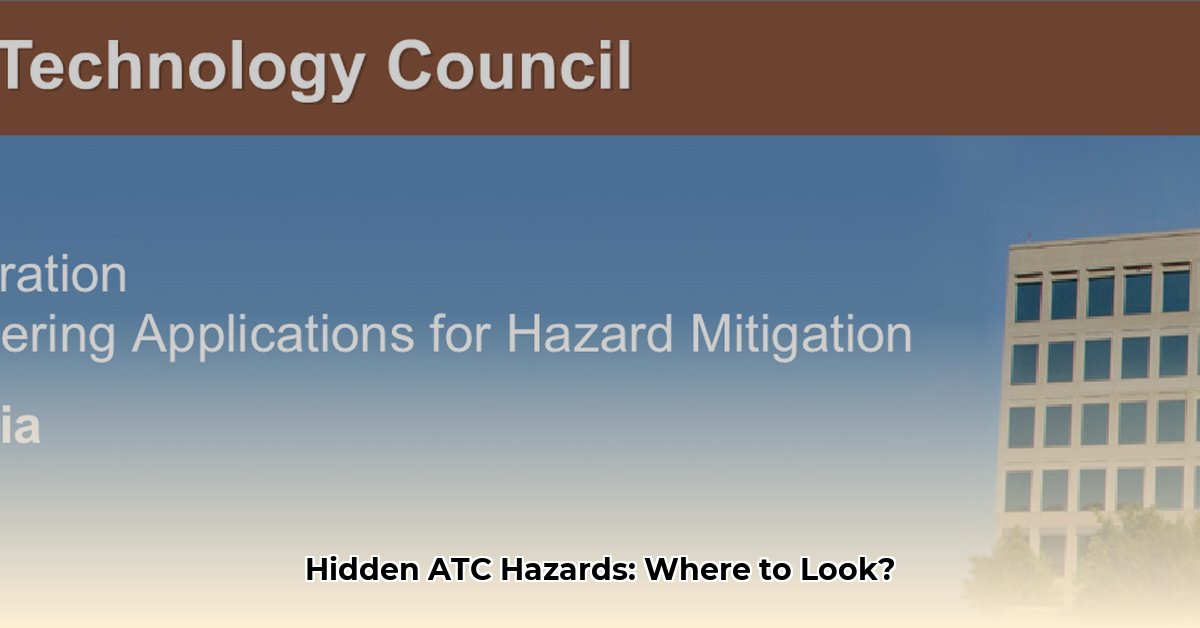Navigating Hazard Data After the ATC Website Transition
Designing resilient structures requires understanding potential hazards. The Applied Technology Council (ATC) website was a primary source for this crucial data, but its closure in 2024 has left many seeking alternatives. This guide provides a roadmap to those resources, explaining the transition and offering practical steps for accessing crucial hazard information. Whether you’re a seasoned engineer or new to the field, this guide will help you navigate the current landscape of hazard data.
Why the Shift?
The American Society of Civil Engineers (ASCE), the leading authority on structural engineering standards, has developed the ASCE 7 standard and the ASCE 7 Hazard Tool. This new system provides a more streamlined and up-to-date approach to accessing hazard data, effectively replacing the former ATC resources.
Understanding and Mitigating ATC Hazards
Before diving into resources, let’s establish a clear understanding of ATC hazards and their significance. These hazards represent potential disruptions to air traffic control, ranging from technical malfunctions and weather events to human error. Mitigating these hazards is crucial for maintaining the safety and efficiency of air travel.
The Human Element
Air traffic controllers operate under immense pressure. Fatigue, stress, and the potential for human error are inherent risks. Ongoing research suggests that improved scheduling, mental health support, and robust training programs can help mitigate these risks.
Systemic Vulnerabilities
Outdated technology, inadequate training, and staffing shortages can create systemic weaknesses within the ATC system. These vulnerabilities can be exacerbated by external factors, increasing the likelihood of incidents. Modernization efforts and ongoing research are essential for addressing these systemic issues.
Unpredictable External Factors
Sudden weather changes, wildlife interference, and unauthorized drone activity represent unpredictable external factors that can disrupt air traffic control. Advanced weather forecasting, wildlife management strategies, and drone detection systems are crucial for mitigating these risks.
The Double-Edged Sword of Technology
While technological advancements like NextGen offer significant potential for enhancing safety and efficiency, they also introduce new challenges. Over-reliance on automation can lead to complacency and difficulties in responding to unexpected situations. Finding the right balance between automation and human oversight is a critical area of ongoing research.
The Broader Impact
ATC safety has far-reaching consequences. Incidents can disrupt flight schedules, damage public confidence, and impact the economy. Continuous improvement and adaptation are essential for managing the evolving risks in air traffic control.
Here’s a summary of potential hazards and mitigation strategies:
| Potential Hazard Category | Specific Example | Potential Consequence | Possible Mitigation |
|---|---|---|---|
| Human Error | Controller fatigue | Miscommunication, delayed reaction time | Mandatory rest periods, workload management tools |
| Systemic Issues | Outdated equipment | Reduced accuracy, system failures | Modernization initiatives, improved maintenance schedules |
| External Factors | Severe weather | Flight diversions, cancellations | Advanced weather prediction, contingency planning |
| Technological Advancements | Over-reliance on automation | Complacency, difficulty responding to unexpected situations | Balanced approach to automation, robust training for controllers |
Accessing Hazard Data: The ASCE 7 Hazard Tool and Beyond
ASCE 7: The New Standard
ASCE 7 is the bedrock of structural design, providing comprehensive guidelines for building loads, including wind, seismic, snow, and ice. The ASCE 7 Hazard Tool simplifies access to these parameters, making it easier than ever to ensure building safety and resilience.
Using the ASCE 7 Hazard Tool: A Step-by-Step Guide
- Access the Tool: Search online for “ASCE 7 Hazard Tool.”
- Specify Project Location: Enter the address or coordinates of your project.
- Select Hazards: Choose the specific hazard data you need (wind speed, seismic design category, etc.).
- Download the Report: The tool will generate a report with the relevant design parameters.
Online tutorials and screenshots are readily available to further assist you in using the tool.
The Importance of Regional Considerations
Building codes often incorporate regional variations to address specific local hazards. Consulting local resources and authorities, like the American Institute of Architects (AIA), is essential for ensuring complete compliance and incorporating region-specific requirements.
Staying Current with ASCE 7
ASCE 7 is regularly updated. Staying informed about these revisions is crucial for maintaining accuracy and compliance in your designs.
Transitioning from ATC to ASCE 7: A Quick Comparison
| Hazard Type | Former ATC Resource | ASCE 7 & Hazard Tool Equivalent |
|---|---|---|
| Wind | Wind Speed Maps | Basic Wind Speed, Wind Directionality Factor |
| Seismic | Seismic Design Categories | Seismic Design Category, Mapped Spectral Response Accelerations |
| Snow | Ground Snow Loads | Ground Snow Load, Snow Exposure Factor |
| Ice | Ice Thickness | Ice Thickness for Atmospheric Icing |
Exploring Additional Resources
For in-depth hazard assessment:
- Consulting Firms: Specializing in specific hazard types can offer expert analysis.
- GIS Software: Provides powerful tools for visualizing and analyzing hazard data.
Beyond Traditional Hazard Analysis: Embracing New Approaches
While traditional methods like HAZOP and FMECA offer value, they may not fully capture the complexities of modern air traffic control. Geo HAZid, a trajectory-based analysis method, offers a more comprehensive approach.
Geo HAZid: A Bird’s-Eye View of Airspace
Geo HAZid analyzes actual aircraft trajectories to identify potential conflict zones, considering both nominal and varied flight paths. This proactive approach allows for the development of targeted mitigation strategies.
Comparing Hazard Analysis Methods:
| Method | Strengths | Weaknesses | Best Use Cases |
|---|---|---|---|
| HAZOP | Systematic, identifies potential problems | May not capture complex interactions | Simpler systems, initial hazard identification |
| FMECA | Focuses on equipment malfunctions | Limited scope | Equipment-specific risk assessment |
| Geo HAZid | Comprehensive, considers real-world aircraft movement | Data-intensive | Complex airspace, proactive safety management |
The Future of Hazard Mitigation
Ongoing research explores the potential of AI, machine learning, and data analytics to revolutionize hazard prediction and mitigation in ATC. These advancements hold promise for creating a safer and more efficient airspace.
Key Resources for Building Design: ASCE 7-22 and Beyond
Designing resilient structures necessitates a comprehensive understanding of structural loads. ASCE 7-22 provides the essential framework for calculating these loads and ensuring structural integrity.
ASCE 7 Hazard Tool: Streamlining Design Values
The ASCE 7 Hazard Tool offers quick and easy access to critical design values, simplifying the design process and ensuring compliance with the latest standards.
AIA Hazard Mitigation Resources: Designing for Resilience
The AIA provides architects and designers with a wealth of resources focused on hazard mitigation, offering practical insights and strategies for creating resilient structures.
Regional Considerations and Local Building Codes
Building codes often incorporate region-specific requirements to address local hazards and environmental conditions. Consulting local building departments and municipalities is paramount for ensuring compliance and incorporating these tailored guidelines.
Staying Informed in a Dynamic Field
Building codes and standards continuously evolve. Staying updated on these changes is crucial for maintaining best practices. Industry publications, professional organizations, and government sources are valuable resources for staying informed.
Key Building Design Resources:
| Resource | Description |
|---|---|
| ASCE 7 Hazard Tool | Quick access to design values for wind, seismic, and other loads. |
| AIA Hazard Mitigation Resources | Curated collection of resources and best practices for hazard mitigation. |
| Local Building Codes | Region-specific regulations; contact your local building department. |
The Evolving Landscape of Building Design
Ongoing research and technological advancements continually reshape building design practices. Staying informed and adapting to these changes is crucial for creating safe and resilient structures for the future.
[American Society of Civil Engineers. (2022). Minimum Design Loads and Associated Criteria for Buildings and Other Structures (ASCE/SEI 7-22). Reston, VA.]
This comprehensive guide provides a pathway to navigating the current landscape of hazard data and building design resources. By embracing these tools and staying informed about the evolving field, we can contribute to a safer and more resilient built environment.
- Boost Your Day: The Ultimate Morning Routine Drink Guide - October 30, 2025
- Unlock Your Potential: Pictures of Personal Growth for Lasting Change - October 28, 2025
- Personal Growth Tattoo Ideas: Discover Your Perfect Symbol - October 26, 2025
















